The Galah – an Aussie Legend That Makes a Great Companion
Ever heard the phrase ‘you flamin’ Galah’? If you’ve ever visited Australia or even watched Australian television then the chances are that you have.
‘You flaming Galah’ is a term coined for someone who has made a fool of themselves, or in the case of soap opera character, Alf Stewart, in Home and Away, when he has been riled by someone.
The phrase dates back to the 1930s and relates to the perceived stupidity of Galahs. However, Galahs, which are part of the Cockatoo family, are actually very intelligent and can be quite a complex bird.
They are lesser known as the Pink and Grey Cockatoo or Rose-Breasted Cockatoo and scientifically known as Eolophus roseicapilla – but the name Galah is the one that people are most familiar with.
They are commonly found in the wild across most parts of Australia, where they are native, but also now in Tasmania and off-shore islands. While Galahs are not native to the UK they have been bred and kept in captivity for many years and in many cases make affectionate pets.
Let’s look at the background of this colourful character, its diet, habitat and behaviour and what you need to know if you are considering taking one as a companion. If you are, however, be warned! They can have a lifespan of around 50 years and one was recorded as having reached the grand old age of 72.
Identification
The Galah is probably one of the easiest birds to spot and identify thanks to its distinct and vibrant colouring. Its body is mainly grey but it has a shock of pink feathers around its head, chest and underneath its wings. Its beak is light, it has grey legs and Galahs are about 14 inches high, weighing in at between 270 and 350 grams.
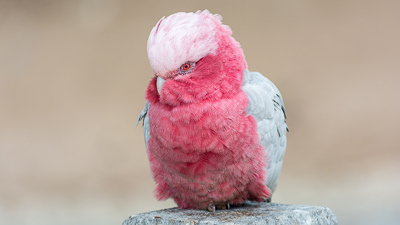
Male and female Galahs look largely the same but can be distinguished by the colour of the irises in their eyes. The male has very dark brown (almost black) irises and the female has mid-brown or red irises.
Adults Galahs are also more brightly coloured than juveniles, which have a greyish breast and head and brown irises.
Galahs have a bouncing flying style and are often seen as part of big, noisy flocks which congregate and roost together at night.
Sub species
There are some sub species of Galah. They are the Eastern Galah, scientifically listed as the Eolophus roseicapilla albiceps), which is different in distinctive features from the Western Australian subspecies, the Eolophus roseicapilla roseicapilla. The third variation is the Eolophus kuhli, known as the Northern Galah as it is to be found in the northern part of the continent. It tends to be a little smaller and is distinguished by differences in the shape and colour of the crest.
Habitat
Galahs are found in large flocks in a variety of timbered habitats, and usually near water, which would explain why they are absent from some of Australia’s driest areas as well as the north of the Cape York Peninsula. Galahs prefers to live in open habitats which offer at least some scattered trees for shelter and are mainly inland.
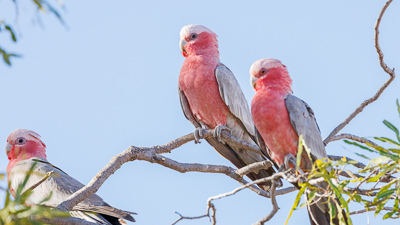
However, the population of Galahs grew rapidly in the 1960s following many escaping from captivity and they are now common in urban and built-up areas such as Adelaide, Perth, and Melbourne. In more recent years, the Galah has started to establish populations in coastal regions.
Breeding
Galahs form permanent pair bonds, although a bird will take a new partner if the other one dies. They will set up a nest in a tree hollow or somewhere similar that is lined with leaves, and both male and female Galahs take on the role of incubating the eggs and caring for the young chicks.
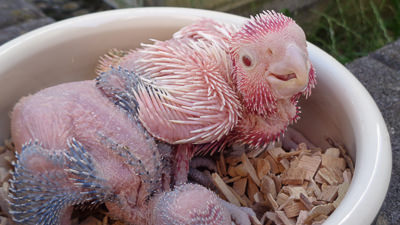
The incubation period is around 25 days and chicks will fledge almost 50 days after being hatched. Each nesting attempt produces three of four eggs in a clutch, but unfortunately, nearly half the chicks die within the first six months.
Breeding season is February to July in the north of Australia and July to December in the south of Australia.
Feeding
Galahs tend to favour a seed-based diet, and in particular from grass and cultivated crops such as wheat, oats and barley. They will also eat nuts, berries, fruit, roots and grubs. In areas where food sources are plentiful, Galahs are commonly found in huge flocks of anything from 500 up to 1,000 birds, and with their sharp chirping sound, they can be very noisy. They prefer to eat early in the morning and late in the afternoon.
Keeping Galahs as Pets
Humans and Galahs can have a complicated relationship. In their native Australia, they feed on crops in huge numbers, causing a lot of damage. As a result, many are shot as pests. Landowners can also legally trap problem birds.
However, Galahs are a common choice around the world as a companion or aviary bird and have a reputation for being affectionate and friendly pets. They are though, best suited to an experienced bird owner as they have specific needs and require a lot of attention and interaction.
How to Keep Them
The approach to choosing a cage for them is ‘the bigger the better’. They need enough room to flap their wings comfortably and to move around. Inside their enclosure, they will need toys, hammocks, ropes and various different perches to keep them occupied. It would be ideal if the cage can be placed in a living room or a busy part of the house so they are always around humans.

Ultra-violet lights are also beneficial as it helps your pet Galah to produce vitamin D3 in their skin, which is necessary for normal growth, strong bones and egg production. UV light also helps with mental wellbeing, which in turn can help to prevent or curb feather plucking or other destructive behaviour.
Cages need to be cleaned and disinfected at least once or twice a week and any faeces, dropped or soiled food should be taken out daily. Galahs enjoy a good lukewarm spray of water during the day and if you do this when the room is warm and bathed in sunlight, they will happily preen themselves until they are dry.
In addition to this, Galahs require at least three to four hours of exercise out of the cage a day to keep their mind and body fit and healthy otherwise they could, again, become destructive.
It is important to bear this in mind if you are considering one, as it means they are a big commitment. As they often live for up to 50 years, do you really have the time to provide this level of exercise each day for the duration of a Galah’s life? If not, it might not be the pet for you.
What to Feed Galahs
As we have covered, Galahs are a seed eating species, so if they are being kept as companions and pets, their diet will need to consist largely of a mix of pellets and seeds. An appropriate seed would be a large parrot mix or fruit and nut mix.
Here at Johnston & Jeff we have blends and mixes of foods that have been formulated with the needs of your Galah in mind.
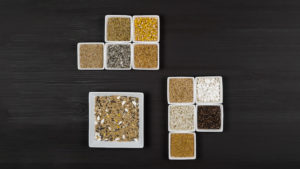
In our Parrot and Parakeet foods, our Galah blend is a low sunflower, low fat forage mix made up of small seeds so Galahs can easily pick them up and eat them as they would naturally. It contains yellow millet, plain canary seed, naked oats, barley, paddy rice, whole maize, pumpkin seed, small dark striped sunflower seed, safflower seed and buckwheat.
However, seeds alone will lack some important vitamins and minerals so their daily feed should be supplemented with small portions of fresh fruit and vegetables. Things like apples, carrots, beans, peas, corn, broccoli and spinach would be ideal, as would our Fruit, Nut, and Veg mix and our Mixed Pulses mix, which is high in protein and low in fat.
Galahs also love individual monkey nuts.
If you need to, you can use vitamin supplements such as Soluvite D or Multivet which can be added to their water supply two or three times a week. Calcium and Iodine can be provided through cuttlebone and iodine bells.
When to Feed Galahs
If you are keeping a Galah as a pet, then it is important to ensure their health and well-being by replicating some of the activities they would do in the wild.
In their natural habitat, a Galah would feed twice a day so this would be the recommended pattern to follow.
It is also worth bearing in mind that Galahs, as do all birds, forage and search for food and this is a normal activity for them, so re-creating this scenario for them in their enclosure keeps them mentally stimulated.
You can do this by having different types of foraging toys available and rotating them in their cage every couple of weeks. These could be wheels, shreddable balls, food towers and bird bells for example.
There are also a range of natural branches of varying lengths, shapes and thicknesses that you could offer your Galah such as eucalyptus, gum, grevillea, bottle brush and lilly pilly. These have natural nuts and flowers that will also provide a foraging opportunity for your Gala, and in addition, will also allow them to exercise their feet and beak by chewing and stripping the perches.
Top Tips for Galahs
Well cared for, Galahs will thrive in a domestic environment. However, there are some common health problems that these birds are prone to.
Firstly, there is Psittacosis which is a type of bacterial lung infection commonly carried by wild and domesticated birds and can be passed onto humans.
Galahs do suffer from respiratory infections, usually caused by bacteria infecting the respiratory system of birds due to vitamin A deficiency, but also can be caused by other factors such as fungi, parasites and environmental toxins.
Lastly, Galahs are prone to bacterial infections and these can be caused by lack of hygiene or stress, especially when there is another factor compromising the bird’s immune system.
Birds can usually cover signs of illness or stress quite well but there are some symptoms to look out for that can indicate something is wrong.
Fluffed up feathers, nasal discharge, lethargy, out of character behaviour, discoloured poo or diarrhoea are all possible signs of disease or illness and you should contact a vet if you spot them.
But with proper care and attention, most of these conditions can be avoided ensuring you and your Galah will enjoy a lifelong friendship and lots of great times together.
To find out more about range of high-quality feeds suitable for your Galah, click here https://johnstonandjeff.co.uk/parrot-match-species-to-blends.
Our recent posts giving advice and guidance on parrots & parakeets
The Galah – an Aussie Legend That Makes a Great Companion
Reading Time: 10 minutes ‘You flaming Galah’ is a term coined for someone who has made a fool of themselves, however, Galahs, which are part of the Cockatoo family, are actually very intelligent and can be quite a complex bird. While Galahs are not native to the UK they have been bred and kept in captivity for many years and in many cases make affectionate pets. Let’s look at the background of this colourful character, its diet, habitat and behaviour and what you need to know if you are considering taking one as a companion.
Ahoy the Mighty Macaws – the Pirate’s Favourite!
Reading Time: 15 minutes Mention the word parrot and the first thing many people think of is a Macaw. Sat abreast many a pirate’s shoulder in books, TV, films and cartoons, these colourful, long-tailed birds are big, beautiful, instantly recognisable as the archetypal parrot, and always happy to take a tasty treat from their owner.
Johnston & Jeff Appointed as Exclusive Distributor of Innovative New Pelleted Bird Food
Reading Time: 6 minutes We are very excited to have been appointed as the exclusive UK distributor for an innovative new pelleted bird feed. Italian manufacturer Fiory has created a cold pressed pellet range called Micropills, suitable for parrots and parakeets, and has signed an exclusive deal with us to sell it in the UK.






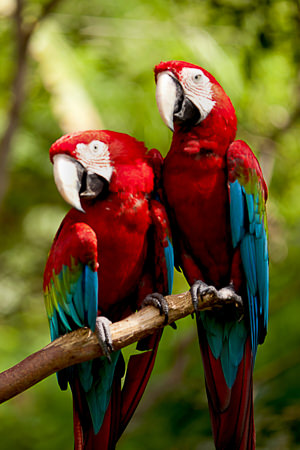
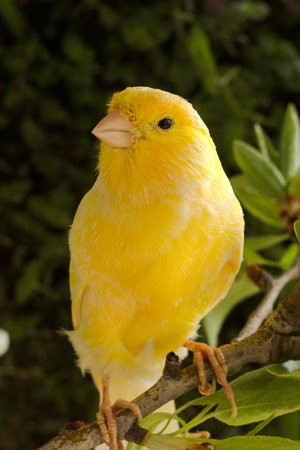
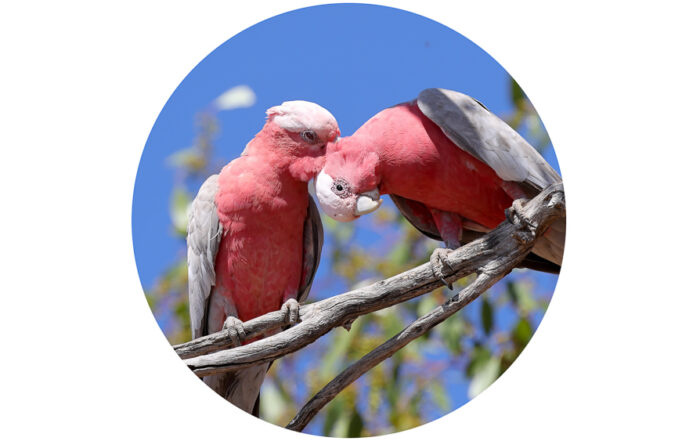

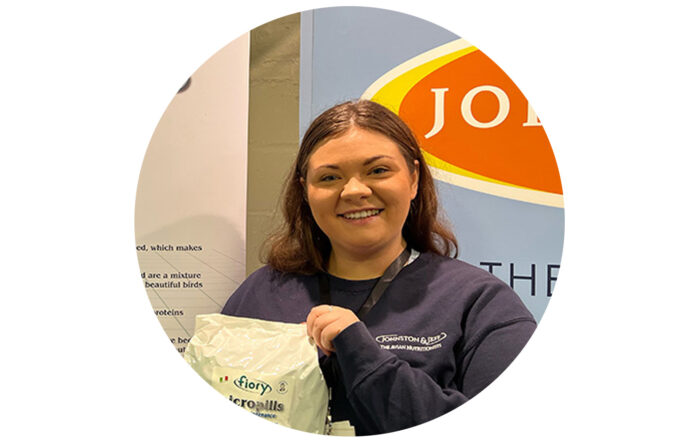
Leave A Comment